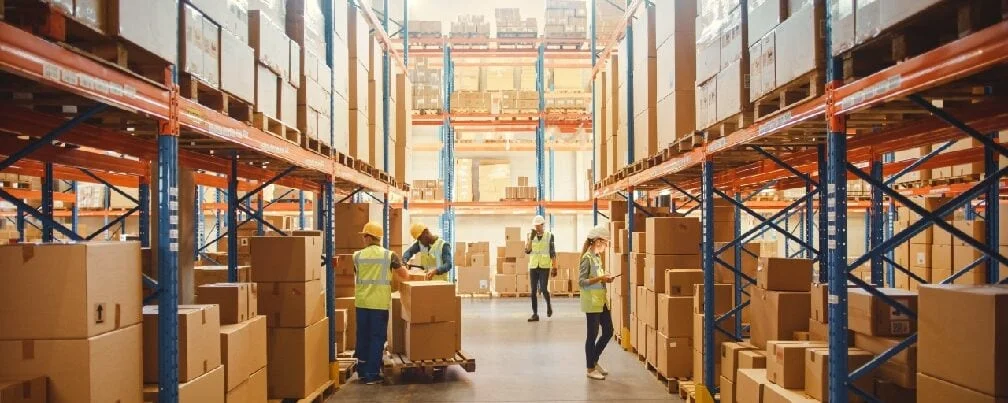End-to-end Warehouse Automation With SAP EWM


Deutsche Amphibolin Werke (DAW), headquartered in Ober-Ramstadt in southern Hesse, has been developing, producing and distributing premium products for buildings and building protection for more than 125 years. Founded in 1895 and family-run for five generations, the DAW group of companies is the umbrella for numerous strong brands. Ober-Ramstadt is also DAW's largest location, where the core brands Alpina and Caparol are produced and where the research and development and innovation departments are based.
In September 2022, the building paints manufacturer opened a new distribution center with a high degree of automation and digitalization. LogiPlus Consulting from Ludwigshafen supported DAW with the conversion of the existing warehouse management solution SAP Warehouse Management (WM) to SAP Extended Warehouse Management (EWM) and with the integration of the technical systems into the SAP landscape during the entire multi-stage project planning. This resulted in the end-to-end automation of intralogistics at the Ober-Ramstadt site.
Initial situation and objectives
DAW faced a number of complex challenges in 2018. A continuous increase in the variety of articles over the last 15 years and changing market requirements led to an increased need for storage capacity, which could no longer be covered by the existing structures on the factory premises. Due to the space problems, DAW had to store goods in various external warehouses and also pick partial product ranges there.
This situation led to an enormous amount of work in inventory management and requirements planning. Picking required a high level of article expertise from employees, as mobile dialogs and forklift control in a proprietary, subordinate system were outdated. Due to the discontinuation of SAP WM and the planned parallel introduction of S/4 Hana, DAW decided to replace the existing IT infrastructure and put it on a completely new footing.
With the aim of optimizing the entire supply chain processes and reducing transport routes, the warehouse locations that were previously spread across the factory premises and external warehouse locations in the region were to be brought together under one roof. In order to create the necessary storage capacity and simultaneously optimize the processes in the warehouse, the concept included the construction of an automated high-bay warehouse (HBW), an auto-store system and an automated, dynamic picking buffer, including the conveyor connection of the various storage areas. The automation of processes was to be accompanied by a considerable reduction in the workload for logistics employees, including the integration of manual areas and existing systems such as conveyor technology. Another key objective was to optimize the workplace design for warehouse employees based on ergonomic criteria.
From SAP WM to EWM
The project included the software integration of all systems in order to efficiently control all logistics processes and ensure ongoing operations. With a view to future-proofing, compatibility and central control of the warehouse in a dominant system, DAW decided to migrate the existing SAP WM system to SAP EWM. As S/4 had not yet been introduced as an ERP system, a decentralized EWM was implemented. "The project consisted of medium and long-term goals. In the medium term, the existing SAP WM and the existing systems had to be replaced by SAP EWM and SAP EWM MFS. In the long term, the SAP EWM processes had to grow in line with the construction progress and the associated commissioning," explains Jörg Martin, Head of Finished Goods Warehouse at DAW.
High-bay warehouse and AutoStore
In April 2020, extensive construction work began on the state-of-the-art logistics center at the Ober-Ramstadt site. Today, the logistics center, which was officially opened in September 2022, comprises an automated high-bay warehouse (HBW) with around 30,000 pallet spaces, an AutoStore system for small containers with three picking stations and 12,000 containers in which around 3,500 items are stored, as well as an automated, dynamic picking buffer with around 1,500 pallet spaces and six picking workstations.
The automated Auto-Store container warehouse operates with seven robots in three-shift operation, which move the required containers to one of a total of four workstations, known as ports. The stock overview is managed centrally in SAP EWM. The buffer warehouse, AutoStore and picking stations are supplied by an electric overhead conveyor (EHB). The pallets for the HBW are automatically transported to one of the eight aisles in the HBW via a conveyor loop and automatically stored and retrieved from here using storage and retrieval machines. Manual picking comprises 1200 picking stations.
An important goal in the design was to switch from the "person-to-goods" strategy to the "goods-to-person" principle. By implementing the "goods-to-person" principle, the distances for employees were reduced and work in the new DAW finished goods warehouse, which operates in three shifts, became highly efficient.
Storage systems in EWM
In the first step, the experts from LogiPlus worked with DAW to replace the existing SAP WM warehouse management system with a decentralized SAP EWM in order to expand the inventory warehouse. By optimizing the material flow with EWM-MFS (Material Flow System), automation solutions such as AutoStore and a forklift control system could then be introduced and integrated into the project. S/4 Hana was implemented downstream as an ERP system and now complements the automated intralogistics landscape at DAW's main site.
"Due to the different automated trades, the biggest advantage was that everything could be connected via EWM-MFS. SAP EWM is therefore the central control unit for all process sequences. The implementation took place during ongoing operations and the delivery service to the customer was ensured in every phase of the project. The overall project enabled external warehouse activities to be fully integrated back into the Ober-Ramstadt site," says Jörg Martin, summarizing the implementation project process.
Thanks to the increased storage capacity, DAW now has all its merchandise, finished goods and packaging under one roof. This has improved the availability of items and the stability of processes, and DAW can offer its customers a better delivery service.
The material flow was improved by running in one direction from the central goods receiving area on the third floor of the logistics building to loading at the ramp on the first floor. Overall, output was increased by 57 percent to around three million delivery note items per year.
AutoStore and SAP EWM
There are various options for connecting AutoStore to SAP EWM. DAW decided not to connect via external middleware, but instead opted for a direct connection via a task interface. This means that stocks and storage locations are managed directly in EWM, making EWM the dominant central control system. Communication between SAP EWM and AutoStore is handled on the basis of TCP/IP in XML format via http.
This allows SAP EWM to transmit all storage and retrieval orders directly to the AutoStore Controller. This central control unit of the AutoStore takes over the route control of the robots and decides which robot can access the required container most efficiently. The operator at the port is guided through the process optimally and intuitively via the user interfaces and dialogs individually developed by LogiPlus. This means that even new employees are quickly up and running.
In general, the topic of automation and therefore the integration of various systems in SAP EWM is at the top of the agenda for many companies. With a direct connection to SAP EWM, companies can create end-to-end processes and thus tap into the full potential in terms of efficiency and performance in intralogistics. The success of LogiPlus customer DAW is a good example of this.




